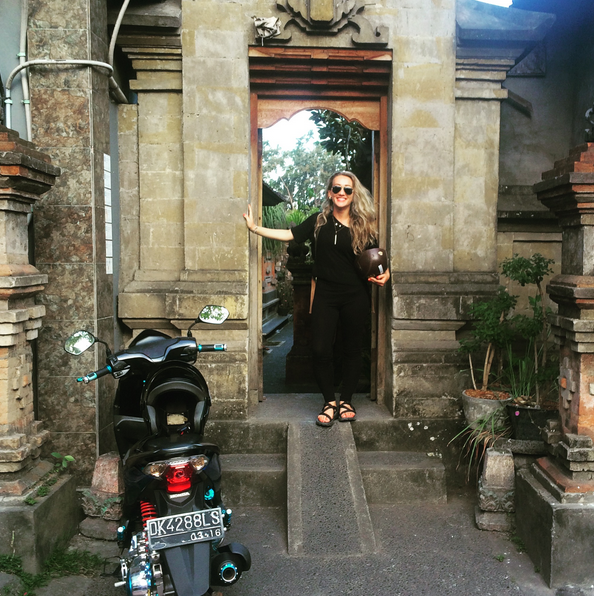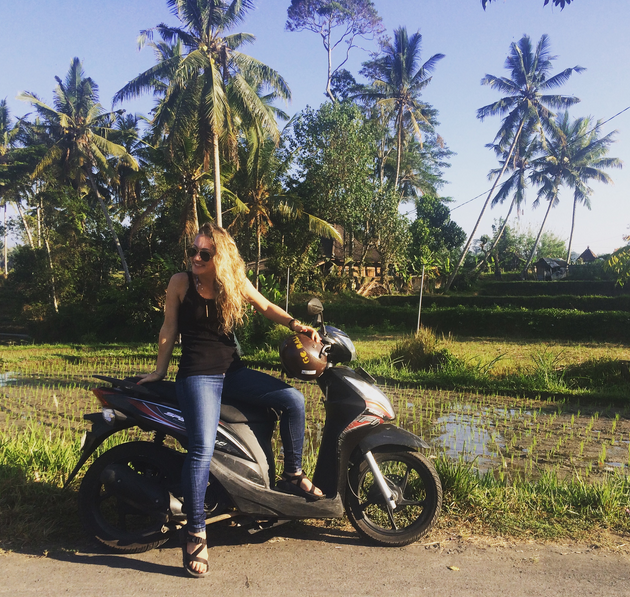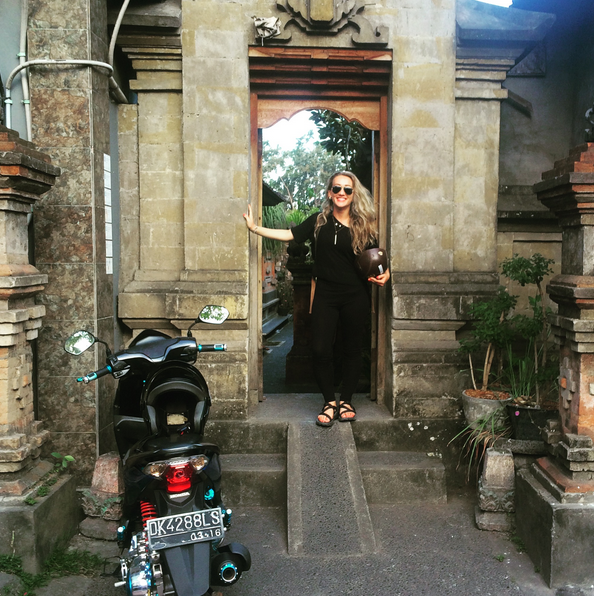This Is What Motorbiking Across Bali Taught Me About Life
My heart pounded against my chest and I hoped the jeans and denim shirt I had chosen to protect my skin would be enough if I toppled over into a gravel pit next to a rice paddy. On one of my first laps through town, motorbikes, cars, trucks with chickens on the back raced around…


Bali is stupidly beautiful, but you wouldn’t notice it at first when you land at Denpasar airport and make the two-hour journey north to Ubud. What you do notice are Balinese families stacked onto motorcycles like small houses of cards, babies swaddled in the left nook of the drivers’ arms like coconuts and only slightly older children hanging on the back, dozing off as if they were sitting in the backseat of the car.
Men drive and smoke cigarettes with no hands and schoolgirls whiz by with friends sitting sideways on the back, toes dangling perilously close to the potholes. Tens of thousands of these motorbikes sped past my taxi window, passing on blind curves and weaving a smoggy, motorized braid of metal and rubber towards Bali’s endless temples and rice paddies, an absolute surrendered belief to the goodness of the universe seeming to govern everyone at the handlebars. Naturally, I mused, I had to try this.
But the old “when in Rome” adage might have well been the end of me. It was my 26th birthday and one of my best friends had flown in from New York to join me for this leg of the trip. We agreed to spend 10 days of pure Bali bliss together before I went north to Laos and made my way towards India solo. Thankfully she’s as adventurous (or moronic) as I am, so I had no trouble persuading her to take a cross-Bali scooter trip with me for my birthday. We rented our motorbikes with surprising ease: a quick check of our international licenses and a stern warning to obey traffic laws, ie. stop at red lights even when the locals don’t.
We had the local equivalent of $10 in small bills for police bribes ready in case we got pulled over for doing something stupid — or just being foreign — and we were off across Ubud for a test run. The bikes turned out to be as easy to drive as Bali is gorgeous, but the tricky part was navigating in Indonesian traffic. My heart pounded against my chest and I hoped the jeans and denim shirt I had chosen to protect my skin would be enough if I toppled over into a gravel pit next to a rice paddy.
On one of my first laps through town, motorbikes, cars, trucks with chickens on the back raced around us and I immediately wondered why I ever imagined Balinese roads as wide beach-side thoroughfares with plenty of cruising room. In one particularly frightening scenario, a truck carrying a giant golden Buddha statue in its flatbed (seriously, only in Bali) cut me off in an unfortunate spot, causing me to stall on a hill at a red light and roll backwards into traffic.
Luckily, several concerned locals pulled up next to me to make sure I was okay. It turns out I was not okay. This was a bad idea. But what do you do when you fall off a horse? I asked myself after a nice Balinese man backed my bike away from the pole and parked it safely for me. You get back on the horse. That’s when the next 5 days of managing Balinese roads began to teach me a lot about life, starting with my notion of fear.
While I’m someone who on repeated occasions has thought nothing of packing up and heading on her own to a foreign part of the globe or hitchhiking around random countries in Asia or descending into small, dark caves in Guatemala with nothing but a 12-year old guide and a candle, I’m not very good at confronting other types of fear, like driving a motorbike, which literally millions of people do everyday. I felt both scared and incapable, and while my instinct was to abandon this dubious brainchild of mine, I was pained knowing an entire island awaited my exploration (or maybe dreaded it and hoped foreign people would stop insisting on driving themselves around). From somewhere way beyond my body’s survival mechanisms, a new-found “if they can do it, I can do it too” determination set in.

Over the next several days, I experienced the raw-dropping sights of Bali at my own speed and discretion, and realized that I had successfully done so by simply focusing on myself. I couldn’t control anything on the road except my own bike and I had a duty to myself and others around me to drive as responsibly as humanly possible.
I maintained a razor sharp focus on what was immediately in front of me and never lost track of the moment. There was no space for daydreaming or navigating or thinking about anything except where my front wheel was going and who was immediately around me. That enhanced sense of presence has to be something close to what monks feel after a week’s worth of good meditation.
It came in handy on a few harrowing occasions where I had to weave my bike between a deep ravine on my left and a long row of trucks on my right and that do-or-die tunnel vision kept me on the narrow ledge of safety. I couldn’t tell myself “don’t hit the trucks, don’t hit the trucks” or else I would have hit the trucks. Instead, I had to focus on where I wanted to go and how I wanted to maneuver, not on where and what I wanted to avoid. How many times do we NOT do that in life? How many times do we look at our past and tell ourselves, “Don’t do that. Don’t repeat that mistake. Don’t fall in love again. Don’t be jealous. Don’t make a fool of yourself.”
We think about the worse case scenario and our lack of focus on the direction we should be going inhibits the wild success that could be. But let me tell you, imagining the best case scenario and living orgasmically in the moment was what kept me on the bike and out of the ditch. In order to be that intensely “in the moment,” a lot of off-road planning had to take place.
Strategy sessions over the map and pulling over to ask locals in our broken Bahasa were the keys to safety. Once we went speeding off, we didn’t dare distract ourselves from our motorcycle zen with navigation of any kind. Each time we stopped to regroup, I kept thinking how setting aside time for contemplation, inspiration, and goal-setting was just as important in our daily lives — an essential type of navigation that could help us stay us focused on the present moment while still reaching a meaningful destination.
I drove slowly and let the Balinese weave around me, blaring their horns in impatience, but I didn’t mind. My true New Yorker best friend had a harder time with that, imploring me to speed up on the next leg, but I never understood why. As much a part of the “next!” generation as the next twenty-something, I was relishing the idea that for once I didn’t need to worry about who or what or where was next and could simply enjoy the breeze and the sun-soaked rice terraces (when another Balinese Buddha truck wasn’t bearing down on me, that is).
So we’d stop on bridges and take pictures; we’d pull over at random temples; we’d pause to go stick our toes in the sand. This is how I wanted to live life, now and forever. Best of all, I learned to believe that I can do anything another human being can do — whether or not that is absolutely fact is irrelevant to the nourishing confidence it invokes. Like the old saying “Imagine you know what you are doing” goes, I am a fear-facing, testifying-under-oath witness to the notion that we can all rise to the occasion when we simply believe, foolishly or not, that we can. ![]()

